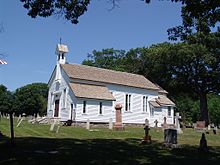
Penetanguishene (usually shortened to Penetang) is a town of about 9,000 (2016) in Simcoe County.
Penetang sits on the south end of Georgian Bay, part of Lake Huron.
Understand
[edit]Historically, Penetanguishene had a large French-speaking population while neighbouring Midland was an English-speaking community. The communities reflect the heritage of both founding peoples.
The name Penetanguishene is believed to come from either the Wyandot or Abenaki via Ojibwe, meaning "land of the white rolling sands". Tourism occupies a considerable portion of its economy with five marinas and shops and restaurants catering to the tourist trade. In the winter, snowmobiling and ice fishing is popular and there is a mid-Winter carnival.
History
[edit]As early as AD 800, the Huron settled in semi-permanent villages in the area. The young French translator, Étienne Brûlé, was the first European to set foot in the Penetanguishene area, some time between 1610 and 1614.
In 1793, John Graves Simcoe, the first Lieutenant Governor of Upper Canada, visited the area and saw its potential as a naval base. He wanted to use the bay to shelter warships to protect British interests on lakes Huron, Erie and Michigan. Beginning in 1814, the British-Canadians built the Penetanguishene Road to provide the area a land route to Barrie and Toronto, as it had been accessible only by water transport along the rivers or across Georgian Bay.
In 1817, naval units were stationed at the Penetanguishene Naval Yard. But, because treaty limitations with the U.S. limited naval power on the Great Lakes, two British armed topsail schooners, HMS Tecumseth and HMS Newash, were laid up "in ordinary", and eventually reported to have sunk at their moorings in the harbour in 1828. Families of Métis fur traders who had moved with the British from Michilimackinac to Drummond Island after the War of 1812, moved again to Penetanguishene. They settled in the town and the surrounding area. Although the naval base was closed in 1834, the military base remained until 1856. Some of the troops settled in the area after their service was complete providing an English-speaking population.
In the 1840s, French-speaking families from Quebec (mainly from the area immediately east of Montreal), attracted by promises of cheap and fertile land, joined the French-speaking Drummond Island settlers already in the area. Later, as the logging industry began to develop, more English-speaking settlers arrived. Penetanguishene became the local market and meeting place for them. Many of Penetanguishene's families today are descended from the Québécois settlers who arrived in the 1800s, giving the town its bilingual nature.
Get in
[edit]By car
[edit]From Toronto, head north on Hwy 400 towards Barrie, Ontario. Continue north from Barrie to Hwy 93 (Exit #121), Penetang is about 20 north on Hwy 93 (45 km)
By bus
[edit]Simcoe County LINX offers service from Barrie.
Get around
[edit]- Mid-Pen Transit. Transit bus service in Midland and Penetanguishene.
- Mercury Taxi, +1 705-549-8877
- Union Taxi, +1 705-549-7666
See
[edit]
- 1 Discovery Harbour, 93 Jury Drive, ☏ +1 705-549-8064. May-Sep: daily 10AM-5PM. The site of an 1812 fortress, this picturesque marine heritage site with 19 reconstructed buildings takes guests back to the 19th-century days of Royal Navy sail on scenic Penetanguishene Bay. Visitors can chat with friendly interpreters aboard the magnificent replica schooners HMS Tecumseth and HMS Bee. The site also features beautiful boardwalks, the waterside restaurant Captain Roberts' Table and historic grounds. Discovery Harbour is also home to the King's Wharf Theatre, which has a programme of popular plays and musicals every summer.
- 2 Penetanguishene Centennial Museum, 13 Burke St, ☏ +1 705-549-2150. Sep-Jun: Tu-Sa 9AM-4:30PM; Jul Aug: M-Sa 9AM-4:30PM; closed on holidays. The history of one of Ontario's oldest communities. Visit the 1875 Lumber Office and General Store owned by late lumber baron and past mayor, Mr. Charles Beck. By donation.

- St. James on-the-Lines, 1 Peel St., ☏ +1 705-549-2223. A small wooden Anglican church built in 1836 to serve the military garrison and civilian population.
- St. Anne's Church, or "Ste Anne's Jesuit Memorial Church: Canadian National Shrine", is sometimes referred to today as the "Cathedral of the North". The church was constructed between 1886 and 1902 by pastor Theophile Francis Laboureau. Laboureau secured major funding for the church from the Bishops of Rouen and Normandy in France as well as the governments of England, France and the United States. As it serves a bilingual Catholic community, services are held in French and English.
Do
[edit]- 1 Awenda Provincial Park, 670 Awenda Park Rd. Daily 8:30AM-11PM. One of most beautiful parts of Georgian Bay shore, with sand, cobble and boulder beaches in sheltered Methodist Point Bay. They are signs of a glaciated past.
Buy
[edit]- Green Block Trading Post, 1 Water St, ☏ +1 705-549-9554. Aboriginal/Metis products, and discount items.
Eat
[edit]- Pan Mai Restaurant, 175 Main St, ☏ +1 705-549-0526. M-Sa 11AM-9PM, Su 11AM-8PM. Chinese restaurant.
Drink
[edit]Sleep
[edit]Go next
[edit]- Midland (Ontario), 5 km away


